We read a lot about the incredibly diverse and otherworldly landscapes of Chile’s Atacama Desert – the highest (8200 ft. asl) and driest desert in the world. As well as the bone-dry, seemingly lifeless and barren expanse that represents part of the desert, there are also volcanoes, numerous mountain ranges, geysers, salt flats, sand dunes, lagoons and hot springs.
In addition to the geological features of the Atacama Desert to explore, I was equally curious about seeing that most South American creature, the llama, in its natural habitat.
We had just left a most delightful soak in mineral-rich hot springs (more on that in a bit), when we came upon a herd of mountain goats on the side of the road. We pulled over to take photos and soon another car pulled up to admire them. The goats were watchful but mainly uninterested in us.
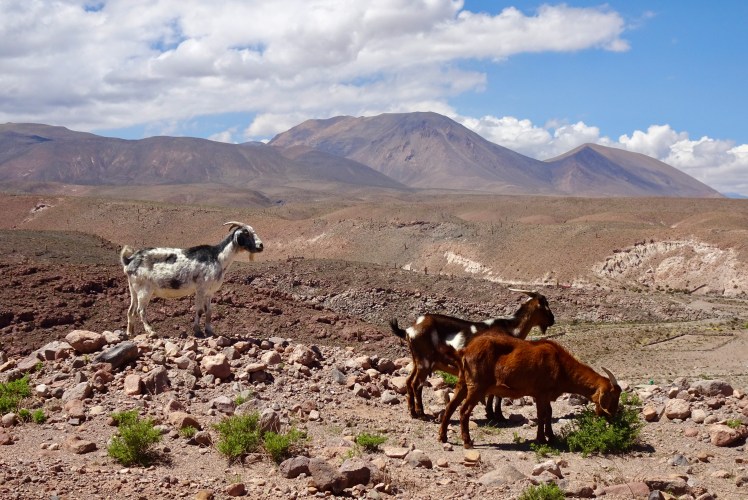
They were soon upstaged by the sight of a couple of llamas climbing up the hill on the opposite side of the road. Within a minute or so, the first llama had reached the road and stopped to peer around rather hesitantly. The other llama climbed up and immediately made a beeline for me.
We were at least 20 feet away from the llamas and in no way threatening them, but apparently this fellow thought differently. He hissed (not a good sign) and began to trot right toward me. As I backed up,I had exactly enough time to think to myself that this wasn’t going to work out well, but without prior knowledge of what to expect from a llama attack. Will he bite me with those camelid teeth? Knock me down and stomp me?
Bam! He crashed right into me and I employed the only weapon on hand – I screamed at the top of my lungs, which stopped him in his tracks. Stephen yelled out, “Run for the car!”, which I did. So did the occupants of the other vehicle and within a minute, we were all gone and peace was restored to the animal kingdom.
Me and the llama, one second before the attack.

As we drove away, it took a while to process what had just happened and get over the shock, but aside from a bump on my shin, I was fine. Our Airbnb host was incredulous, as this is very unusual behaviour but he judged from the photo that this llama was young and quite possibly had separated from his family and was feeling insecure.
It didn’t change my affection for these funny characters and we’ve seen numerous llamas and vicunas since. This handsome fellow was part of a domesticated herd: they all had festive ribbons attached to their ears. We just kept our distance and stayed safely in the car.
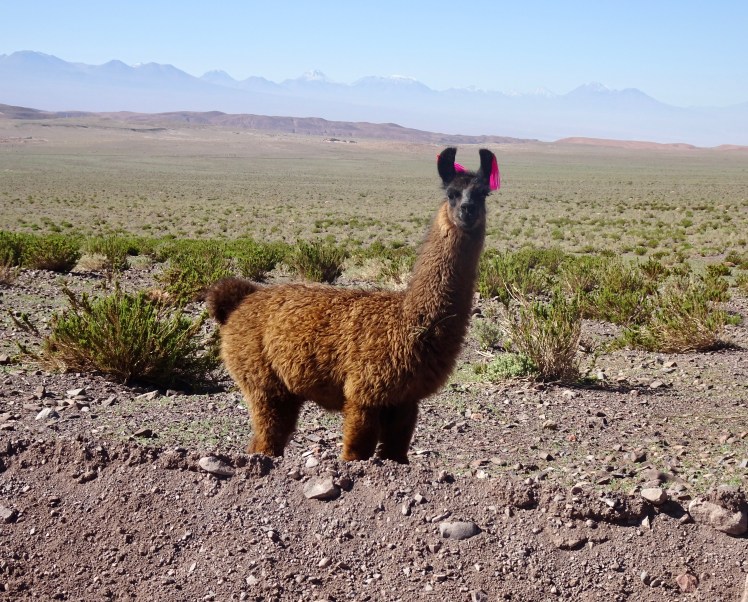
When contemplating our trip to the Atacama, we had two choices – rent a car and explore on our own, or grab a bus into San Pedro and sign up for tours. Two things decided it for us – we wanted the independence of touring around at our own pace and we found this cute little place on Airbnb.
It is six km. out of the town of San Pedro and we thought it might be quite special to enjoy the cool night desert air, listen to the night desert sounds and walk out our front door to watch the night sky.

It was perfect in many ways. Our hosts, Juan and Veronica, could not have been more charming and helpful. They live in another house onsite with their two little kids and their dog Pancho.
Juan is a tour guide and Veronica works as a liaison between a Canadian mining company and local indigenous populations in a number of towns in the desert. As Juan pointed out, there is a contradiction there. He works to promote and maintain the natural beauty of the area and his wife is working for a company who wants to tear up part of that same countryside.
For things we all need – like copper, salt and lithium. Especially lithium – the Atacama desert holds one-quarter of the world’s reserves, and without lithium we have no batteries for our devices. An interesting complicated situation that has no clear right or wrong answer.
Juan was invaluable in helping us plan our daily excursions – he was full of insider tips, accurate directions and reassurances about our being able to handle the rough roads with our little rental car.
We also had the privilege of walking out to the yard later in the evening or first thing in the morning to see the stars. They were incredible in their milky brilliance; billions of stars twinkling in a pitch black sky. Apparently the best time to see the night sky is during the crisp cool months of July and August; this time of year the sky is often obscured by cloud. (No great photos to show you, unfortunately.)
San Pedro de Atacama is the only town of consequence for many miles; a beacon of civilization with a number of hotels, hostels and Airbnbs. It is well served with many restaurants, shops, and of course, tour companies on every corner. I had imagined a South American Santa Fe, but it has not yet been “up-scaled”. The adobe buildings are modest, many of the streets are still dirt, and there is a fine layer of red dust on everything.
Still, it has a certain charm to it, and we enjoyed wandering the streets.

An entrance to a hotel, with typical adobe walls.
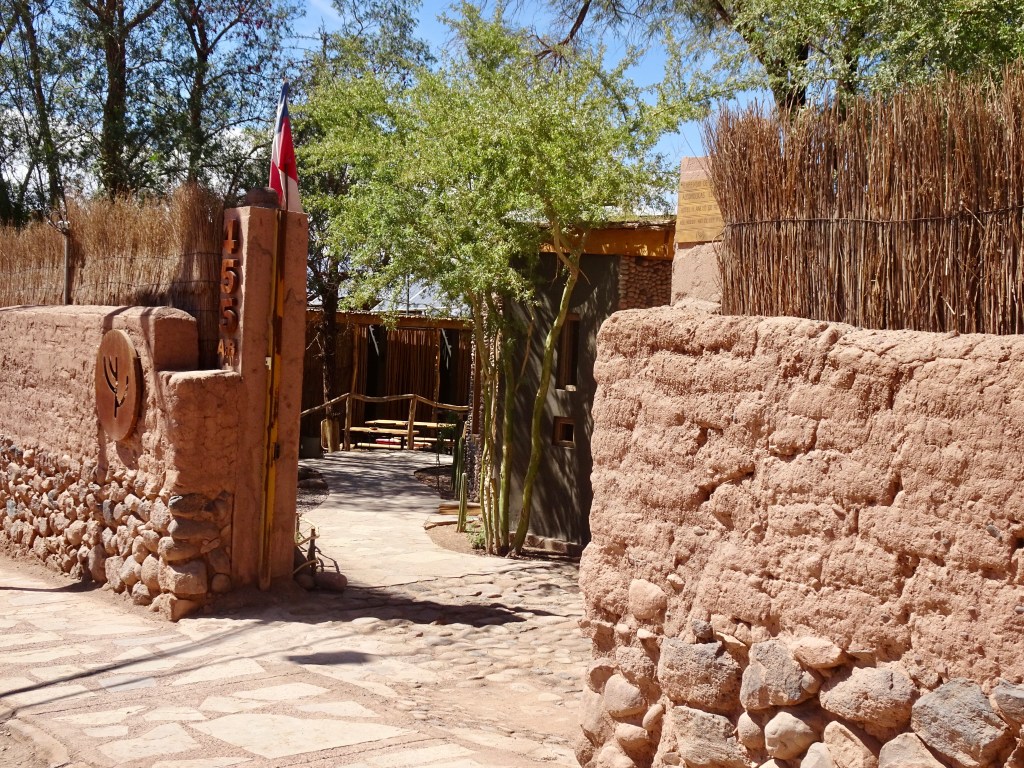
One of our favourite restaurants – La Franchuteria. A French restaurant specializing in exquisite baguette, croissant, pain au chocolat, etc. A 15-inch baguette served on a board with goat cheese and pate on the side to share – a perfect lunch.

So back to the main story – our lucky introduction to Chile being the phenomenal, mind-blowing, astonishing splendour of the Atacama Desert.
I have to say, in terms of offering up otherworldly landscape, quirky animal life and nature at its most extravagant, the Atacama is giving Galapagos a run for its money.

I would never want to live in a desert – too hot, too little water, and a sense of peril if you lose your way or run out of gas, but I love visiting them. The desert does know how to put on an exciting show.
The park rangers have thoughtfully marked all trails with rock pathways and frequent “No Pasar” signs, so only the most determined rule-breaker could get lost out here.
Driving, however, is a different challenge. There are a few paved roads through the desert, but most of them are dirt, in varying states of repair. Some are smooth, graded and flat – a pleasure to drive, especially since most of the time you have the road to yourself, with nothing to get in the way of the view.

But there are also the roads that require nerves, stamina and close attention, lest you pop a tire in the middle of nowhere.
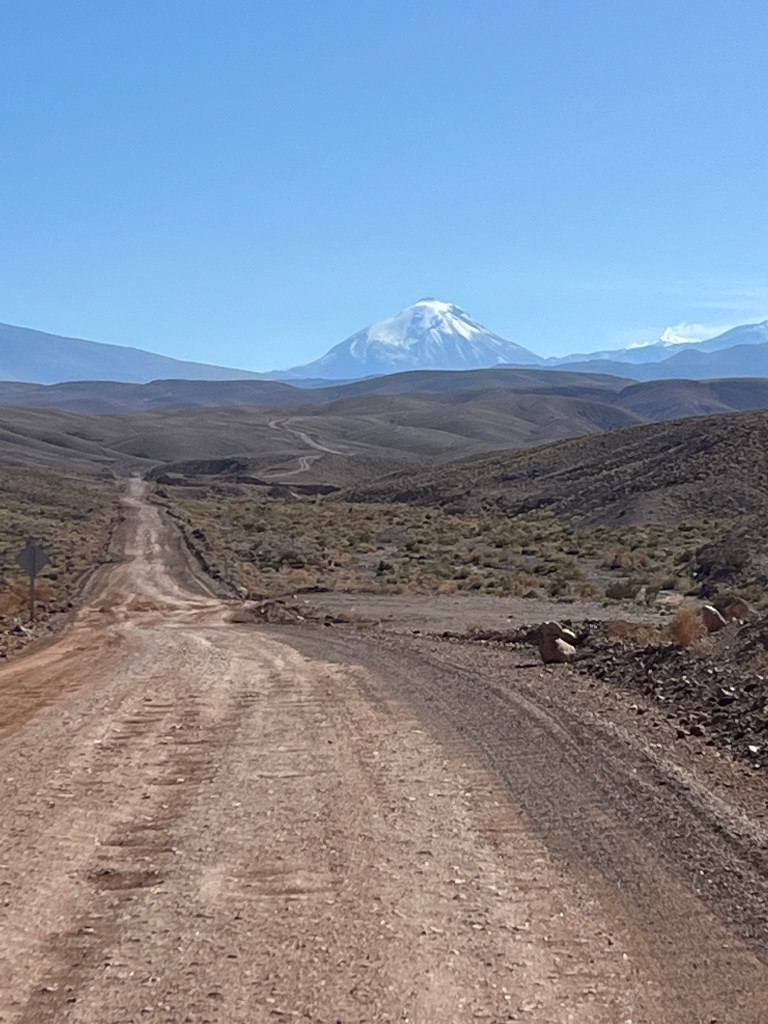
We never took photos of the corduroy road we had to endure for almost 20 km. one morning on our way to the El Tatio geyser field – a bone-rattling, suspension-shaking trip that was almost enough to make us turn around and go back. The reason for this stretch of road being in this condition is the very high altitude and without the grooves, the early morning ice would make driving too treacherous.
This is the point where I suggest you rent a 4×4 truck, rather than a little Peugeot. We opted for the latter as it was $300 a week, with the 4×4’s running double that. We were never unsafe in our small car, as long as we drove slowly (“we” being Stephen doing all the driving, you should know) but we would have been a lot more comfortable in a more road-appropriate vehicle.
Another example of a stretch of road that was best navigated carefully, in daylight and sober.
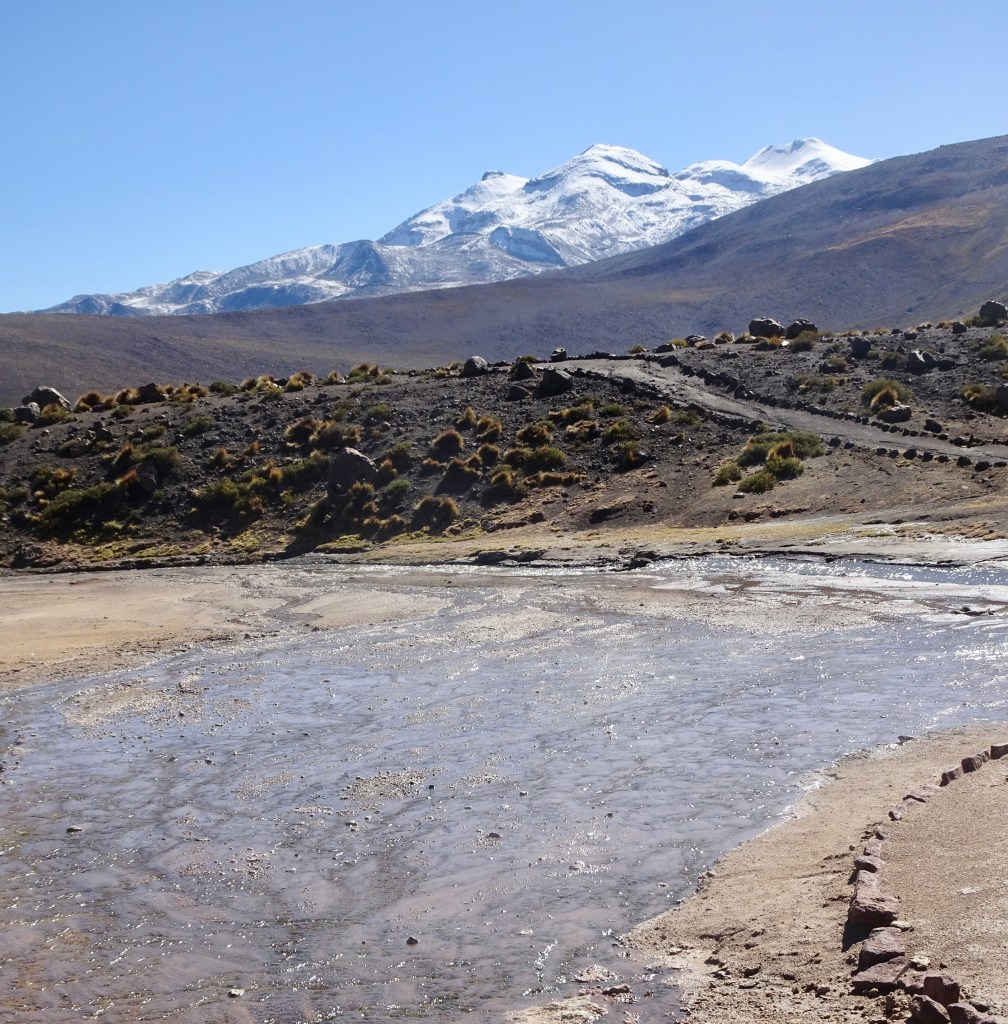
If driving these roads by car is challenging, you can imagine travelling by motorcycle. We ran into a group who were from Argentina – a middle-aged odyssey in the spirit of Che Guevara’s Motorcycle Diaries, but with van backup and better bikes. (Royal Ensigns).

It would take many blog postings (and much research on my part) to cover the geological marvel of the Atacama. This area is 250 million years in the making, has survived three mass extinctions, disappearances of massive lakes, bashing of tectonic plates, eruptions that created mountain ranges, and bits of ash and rock that migrated to create the colourful Valle de Arcoiris (Rainbow Valley).
Everything we have seen reflects ancient geological turmoil, and each site offers quite extensive explanations for what is in front of you. In the interest of not making this posting three times longer than I already know it will be, please excuse me if I make this less facts and more photos.
Laguna Cejar and Piedra are brackish lagoons located about 20 km. from San Pedro. While Cejar loomed in an expanse of salt flat, with just a glimmer of water on the horizon, Piedra was an oasis.
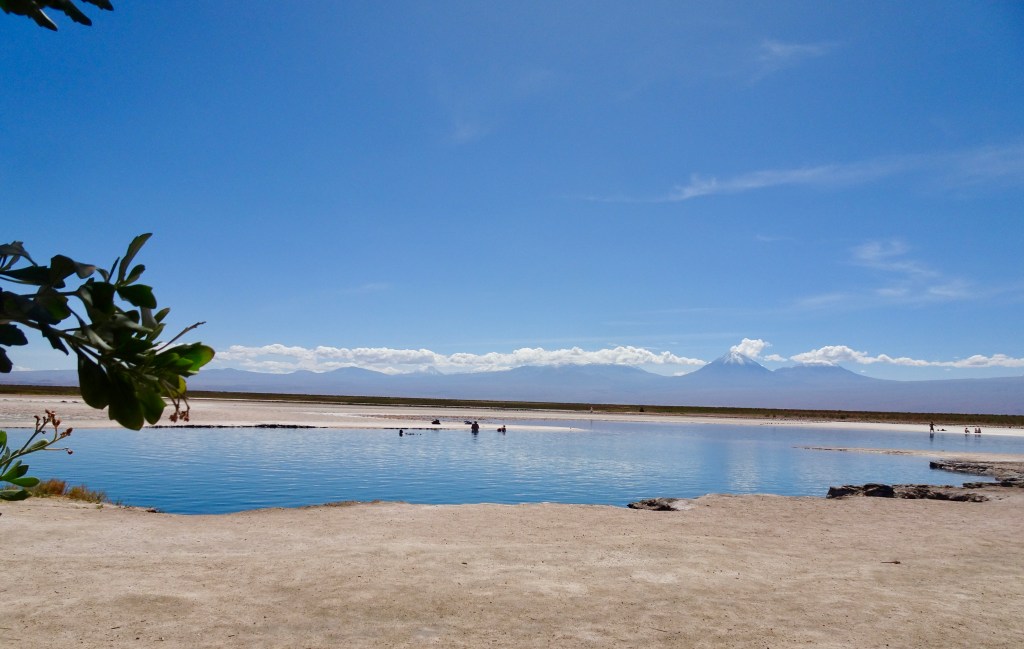
The water is so densely salted that you simply float; you probably couldn’t sink if you tried. It is quite delicious to just lie back and let the water hold you. When I attempted to float on my tummy, I felt like a turtle who had flipped onto its shell; the lagoon wanted me to stop resisting and just float on my back.
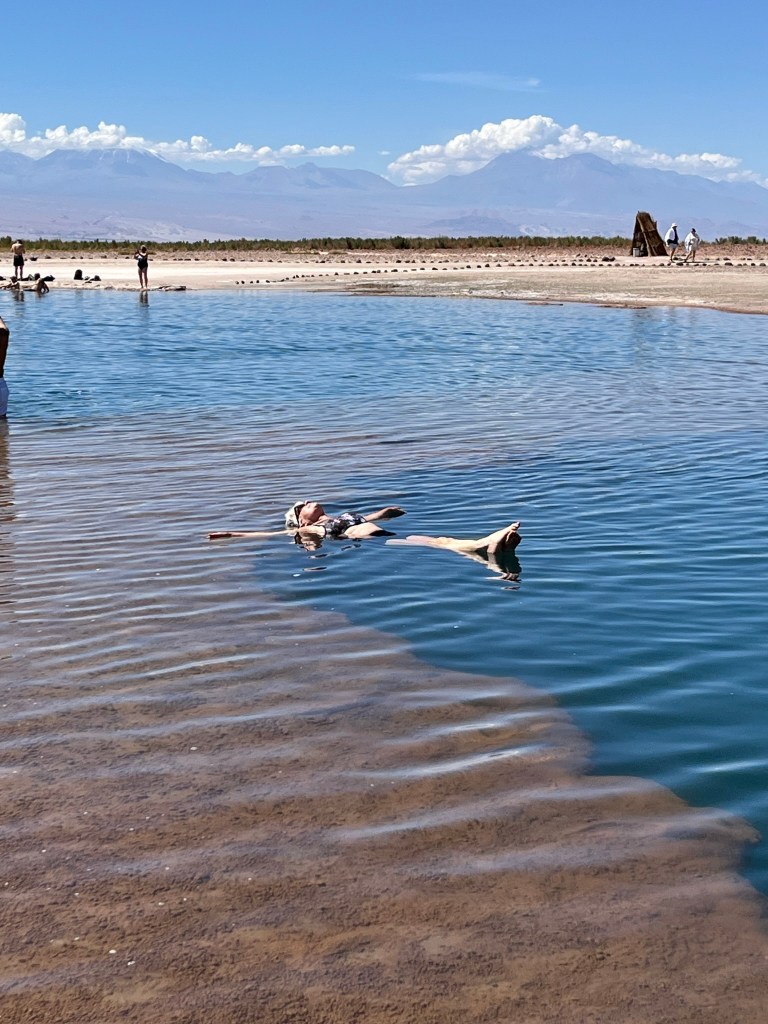
Just a few kilometres away, we visited the Ojos del Salar and Tebingunche Lagoons – neither of them swimmable.
The Ojos del Salar are twin “eyes” – deep lagoons on either side of the road.
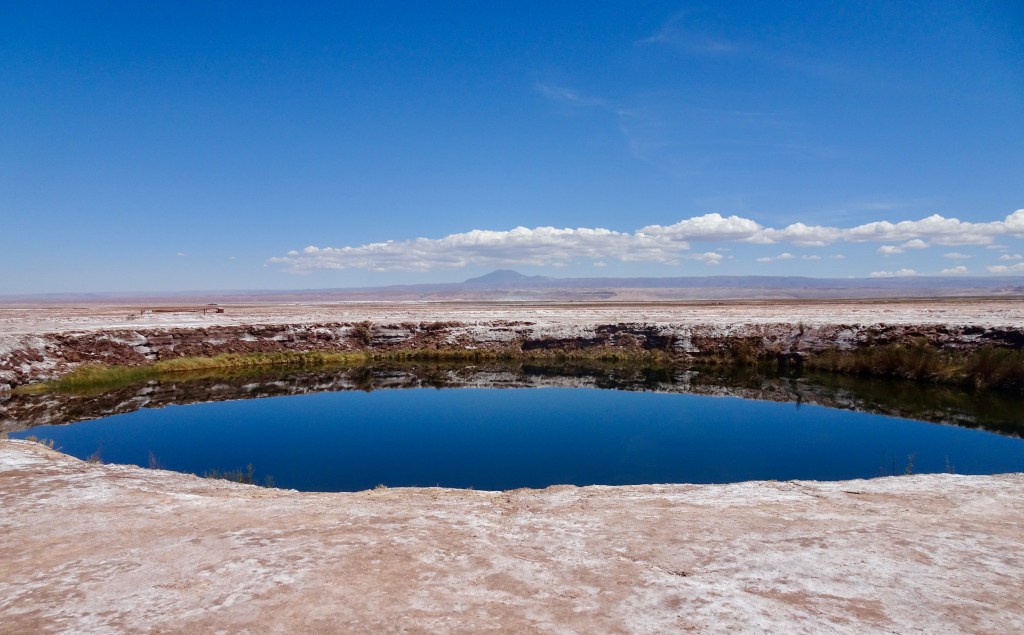
The Tebinguinche Lagoon was like a large Asian watercolour, and just about as serene to walk along the path, admiring the reflection of the volcanoes.

This has got to qualify as the world’s most desolate job – hanging out in this little hut on the salt flat to take admission fees from visitors who drop by once every half hour.

The Valle de Luna is an easy 12 km. drive from town to a wide bowl surrounded by desert dunes, craggy rock formations and hills of the Cordilla de la Sal. We went there our first day as it was lower elevation and we needed to acclimatize. It was an incredibly dramatic introduction.
We met these two burros along the way (pronounced “burrr-ro” in Spanish), who apparently subsist on rocks and saliva.

Lunar-like surfaces and oversized rock formations.
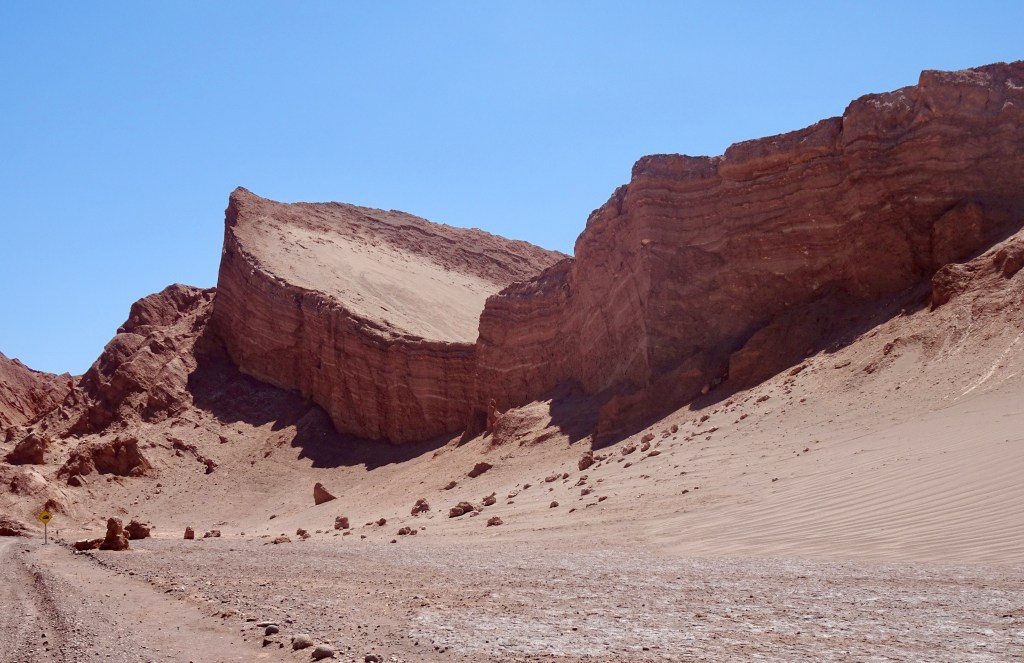
Salt formations.
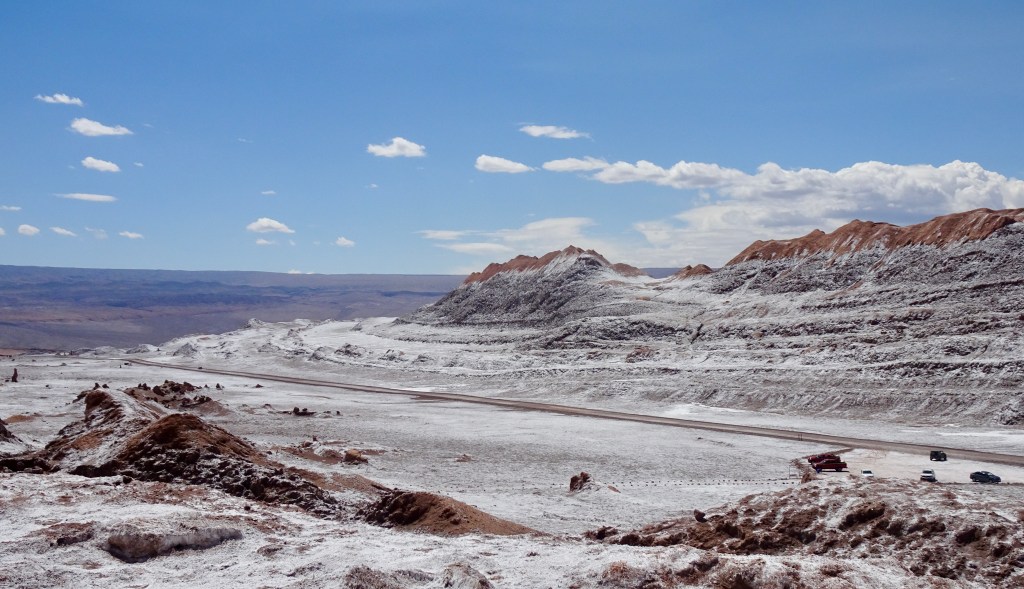
The Instagram photo spot. If I may take a moment to rail again influencers. We had climbed up to the pinnacle on the right of the photo, and after about 10 minutes or so or enjoying the view, we decided to make our way back down.
Three young women had been at the same pinnacle, contorting in every imaginable pose for what seemed like hours, in search of the perfect shot. It was an annoying distraction from the glory of this jaw-dropping view, but what was even more annoying was what followed.
We had begun to back down to a point where we could reach stable footing and begin our descent, when one of them called out to us and asked us to get out of their way because they wanted to grab a photo from that angle. Presumably they wanted us to climb back up and wait until they were done.
Miraculously, neither of us lost our cool, but we just ignored them and then proceeded to slooowly climb down.

More cute and cuddly llamas.
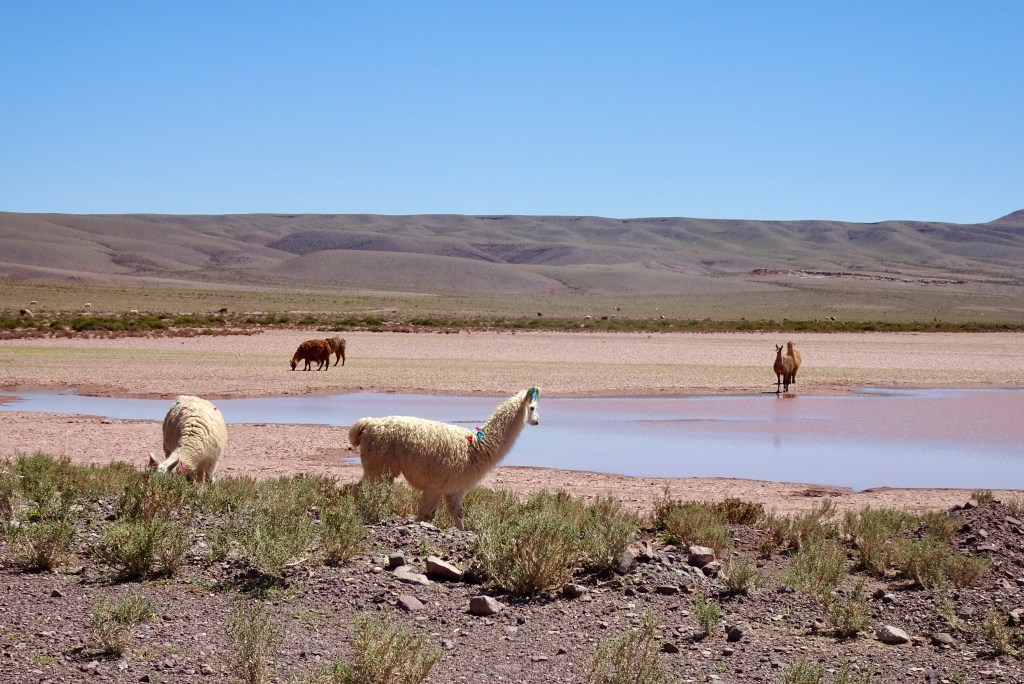
Just as cute, but less cuddly – the vicuna. Smaller than the llama and very timid, they were hunted for their very expensive wool, but are now protected and their numbers are growing. They can only be found at high altitudes. We saw this herd on our way back from visiting the El Tatio geysers.
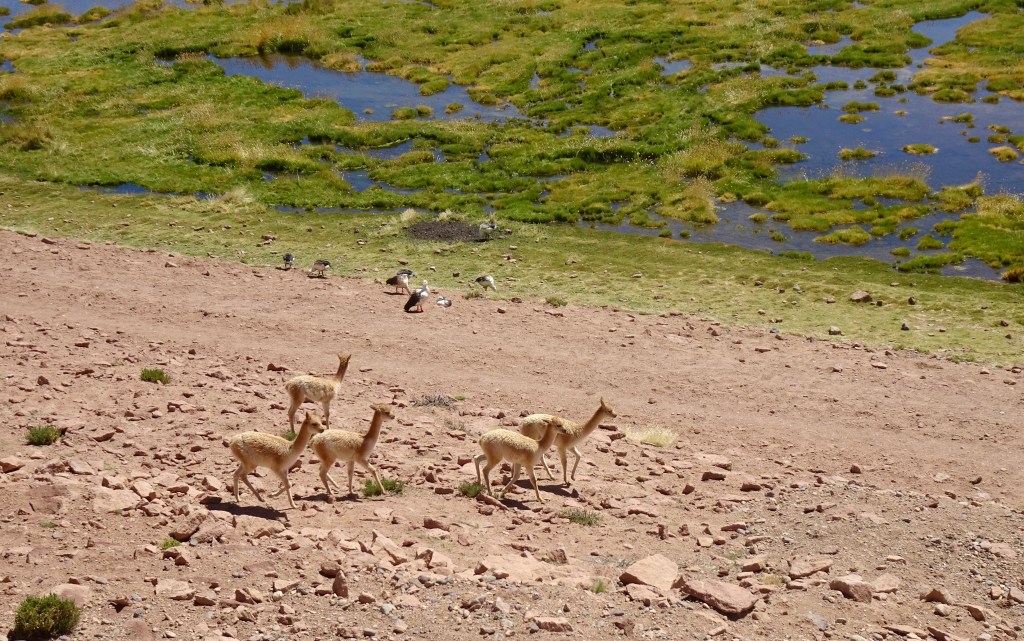
The El Tatio geyser is one of the Atacama Desert’s main attractions. They are the third largest geyser field in the world and the largest in the southern hemisphere, and at 4320 m. above sea level, you need to have your altitude lungs in place.
Tour vans run very early – leaving town at 4 a.m. to arrive before sunrise, in order to observe the spectacle of the steam rising up to six meters in the air, with the pink sky as a backdrop. This all sounded lovely, except for the 4 a.m. rise part, so we opted instead (at our host’s advice), to leave at 7:00 a.m., arriving around 9:00, just as the tour vans were leaving.
We had the place to ourselves and the geysers were no less showy.
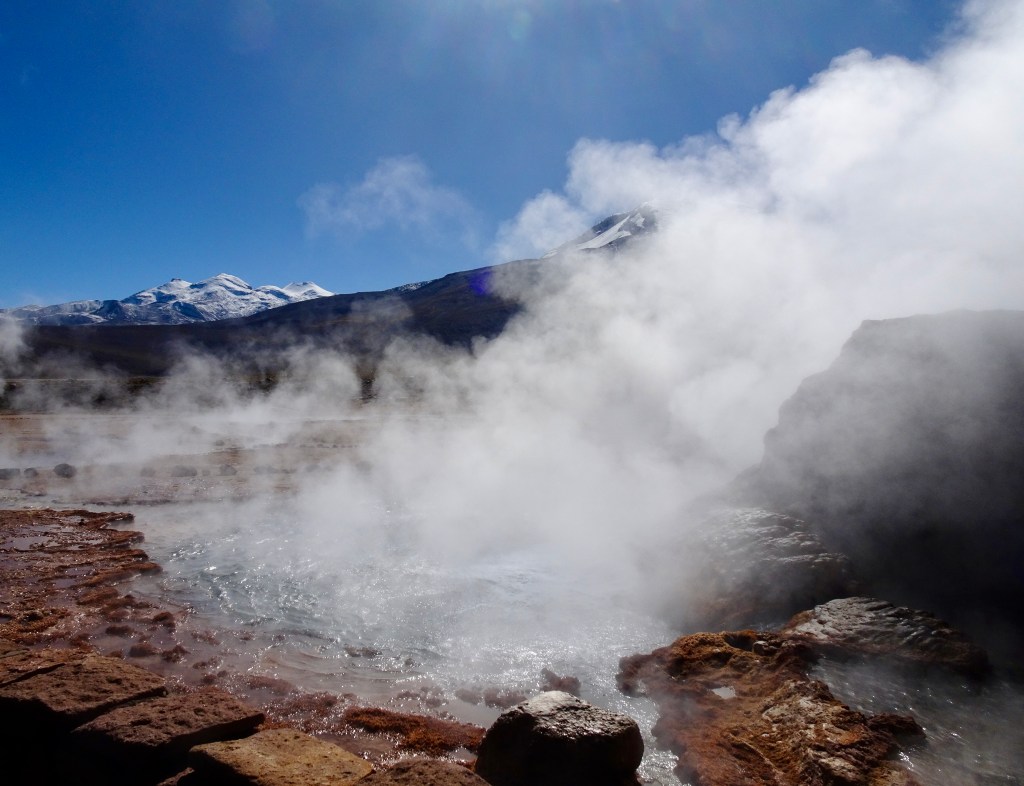
It was a considerable field to wander about and in addition to the several very large geysers, which bubbled and spewed out boiling water, there were dozens of fissures with steam escaping from the ground.

There used to be a thermal bath on the site as well but it is now closed, possibly due to Covid, and has not reopened again.
There are thermal baths that are open to the public – the Puritama Hot Springs. These are located at the bottom of a ravine, along a river that runs at 33 degrees. After we paid our admission, we walked for about 5-10 minutes down this path to the entry.
The park has done a beautiful job of harnessing this water into eight pools, ranging from quite hot to cool-ish. Each pool is distinctive and lush, surrounded by huge boulders and Pampas grass.

You are supposed to start at the coolest one and work your way up, but my Spanish being what it is, I misunderstood.
We began at the hottest pool – a soul-satisfying soak in rich mineral water with the added bonus of taking a turn at the waterfall.
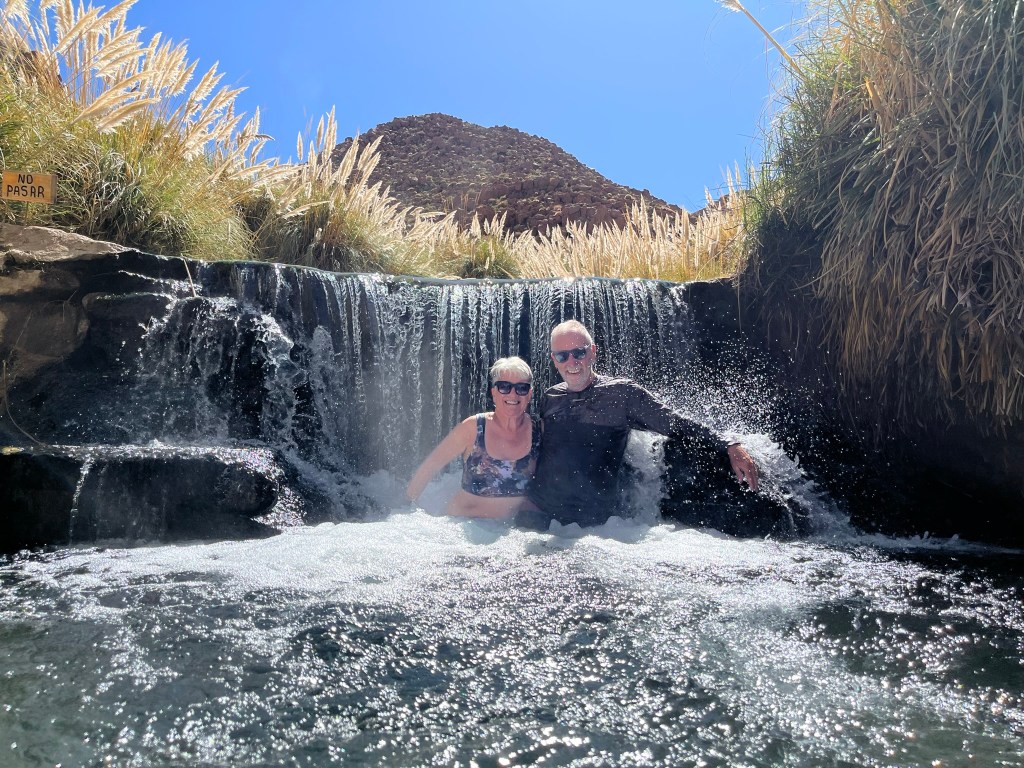
The Valle de Arcoiris (Rainbow Valley) is a collection of multi-coloured rock formations set in a valley of slot canyons.
This was created by a waterfall eons ago – this formation is what remains.
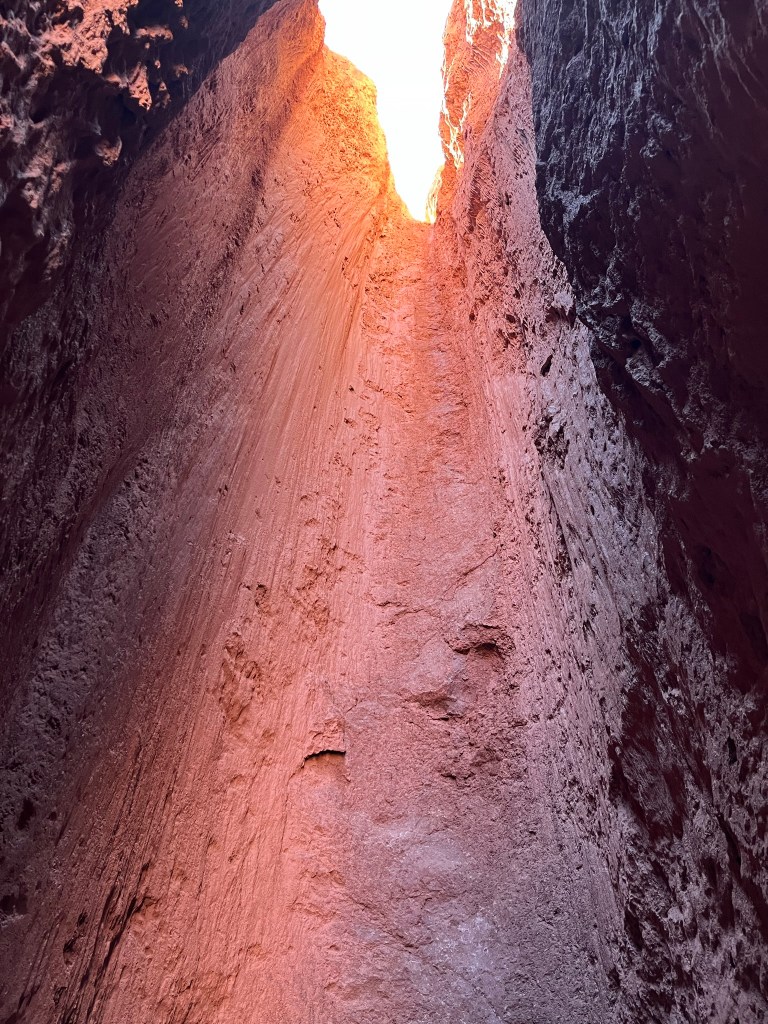
The entrance to the slot canyon.
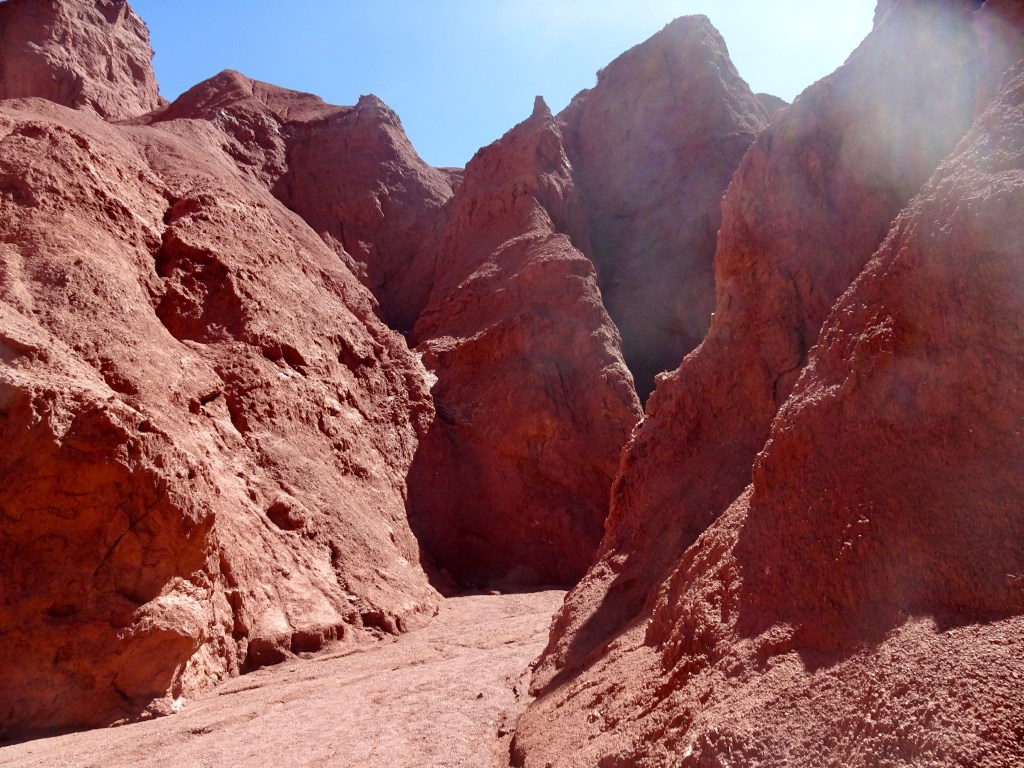
Glorious colour contrasts.
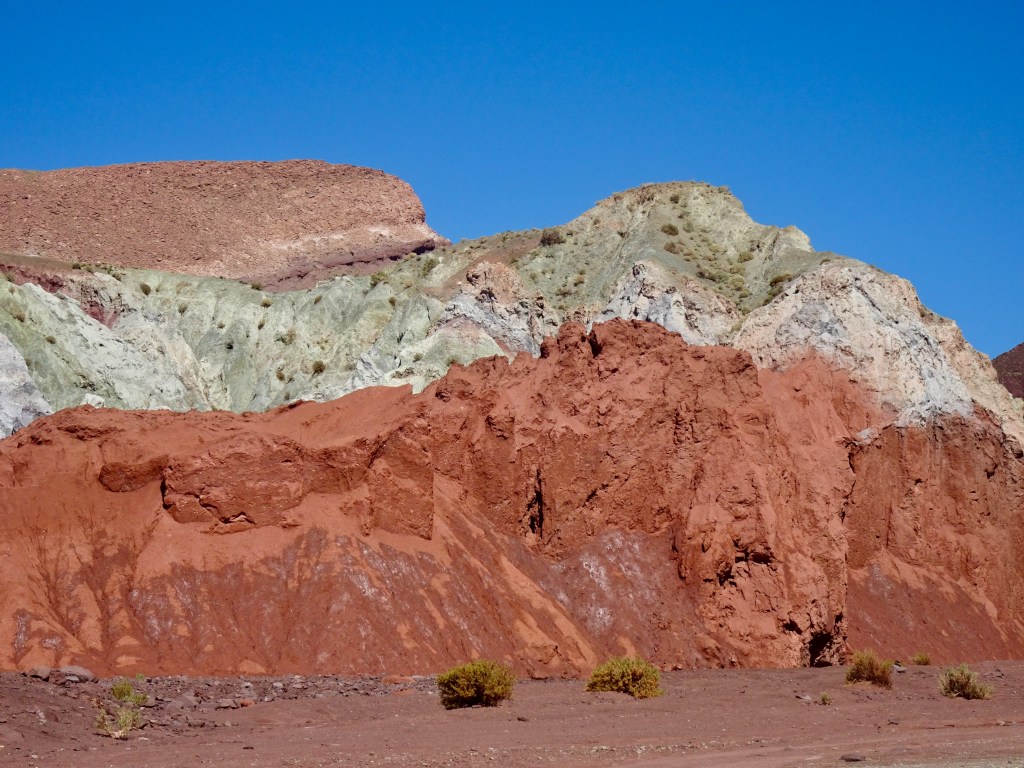
Spiky rock formations.
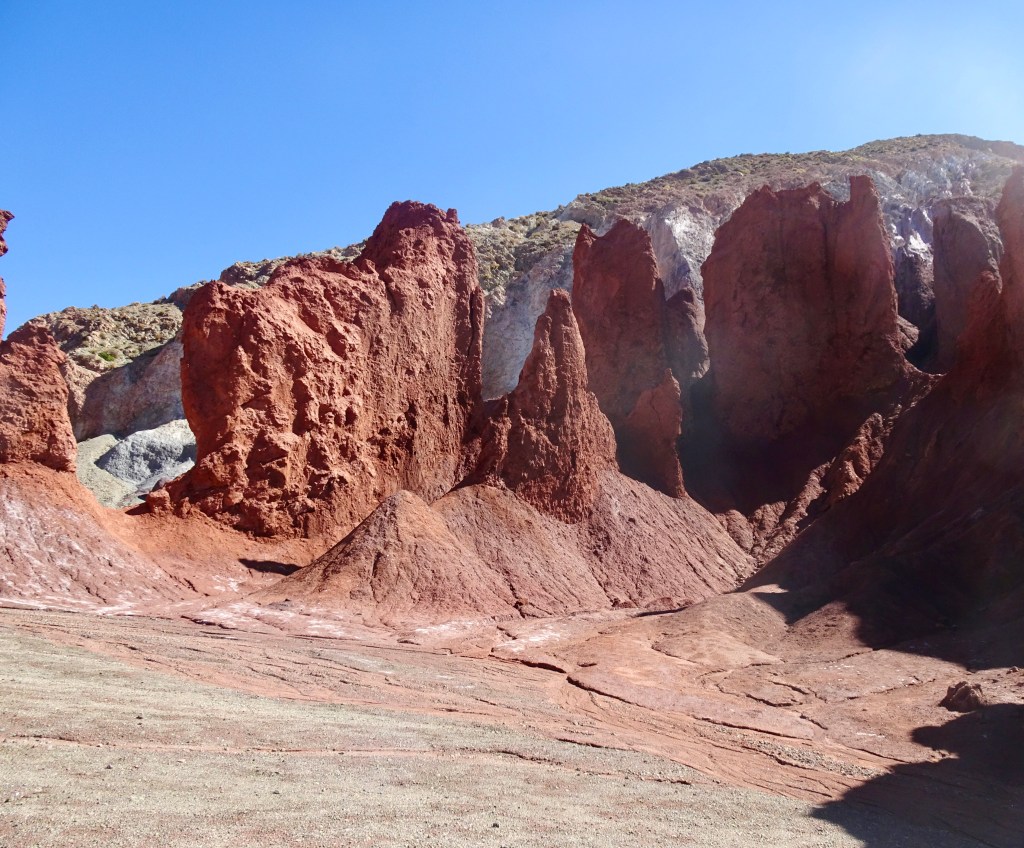
And, to discover another distinctive part of the desert, we went to the Salar de Atacama, a natural reserve for flamingos and migratory birds.
The lagoon is rich with the tiny crustaceans that flamingos thrive on, and provides a resting and feeding ground for the sandpipers and plovers that are making their way back to Canada.

Although the lagoon supports a good number of flamingos, most of them were at the far reaches of the water. Occasionally, a few of them would fly overhead to another feeding area.
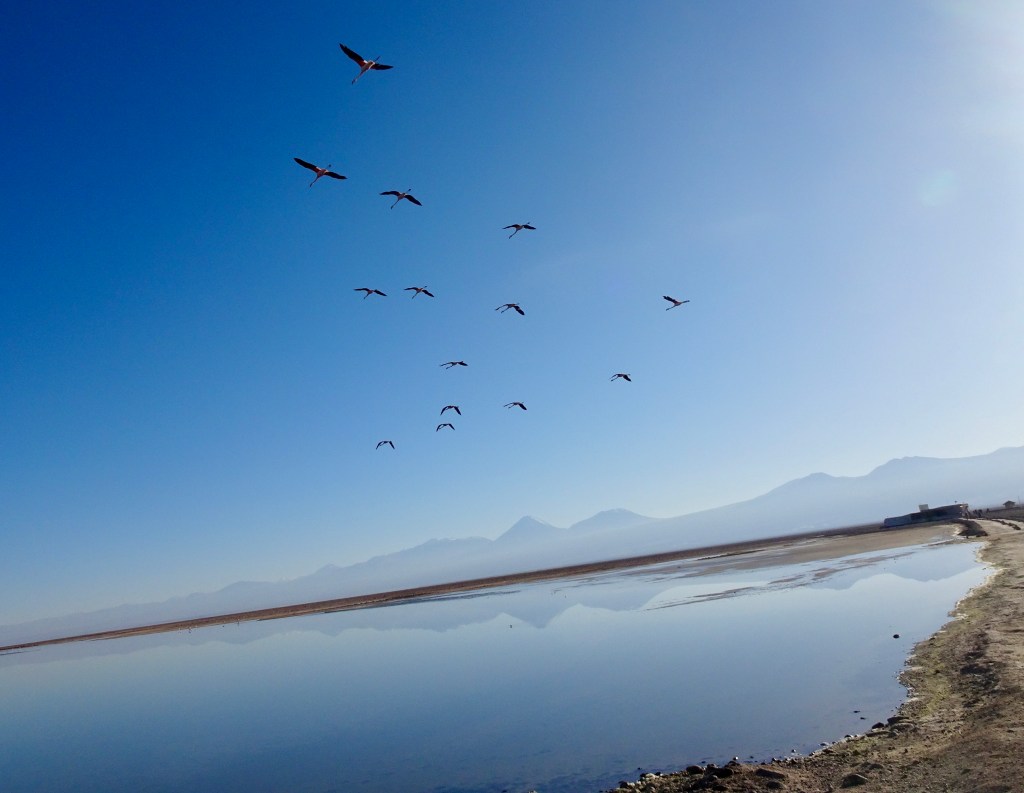
We watched these two do their funny little feeding dance on their spindly hinged legs. With head underwater, they would rotate and dig, rotate and dig and eventually come back up for air.

Once upon a time, this was a huge lake. As far as the eye can see was once water, and that has been replaced with a salt flat.

This flamingo lives in another part of the desert, in a marsh, sharing its space with other flamingos and vicuna.

Now that I have put this all down on paper, I think the Atacama Desert and Galapagos Islands are a very close tie. In both cases, you are aware of being in a place that keenly reminds you of the earth’s origins, and how the harsh conditions that exist in both places have created their unique landscapes and inhabitants.
The Atacama Desert has far surpassed our expectations and really set the tone for our time in Chile. We are off to the Lake District in central Chile tomorrow and will travel about there for two weeks.
In the meantime, I’ll leave you with an image of a vicuna. They say vicunas are shy, but looks can be deceiving. I bet he is resting up after an attack on an innocent, unsuspecting human.
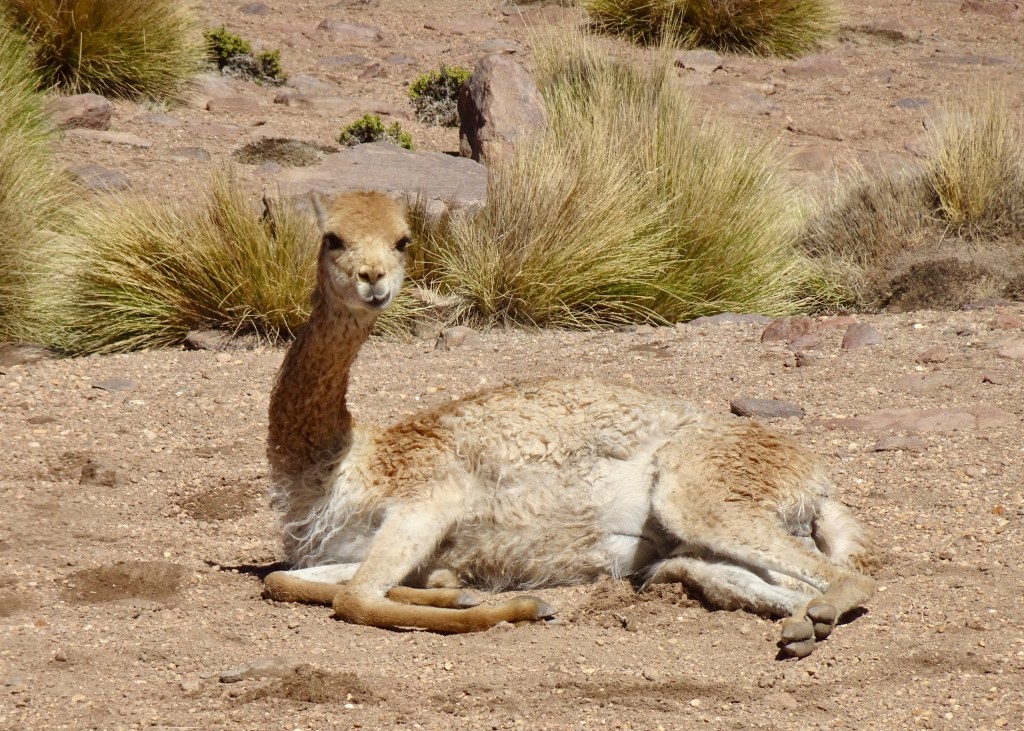
Alright already. You have convinced me. I never thought I would want to visit a desert, being a tree hugger by birth. However your pictures and descriptions have brought it alive. And the comparison to the Galapagos which was perhaps our most exotic travel experience. In your South American travels you have brought back so many good memories. Thank you.
LikeLike
I know – to me a desert was always about heat, sand, lack of water and perhaps a snake or two; a cactus. But we loved visiting the deserts in southern California so much – each one a bit different from the last and the Atacama is the grand daddy of them all. A week wasn’t enough – we missed a fair bit – would love to return one day.
LikeLike
Here we go!!
Brings back a lot of nice memories!
My son and his wife went horseback riding for hours with a guide and loved it!
For me getting up at five am and seeing the millions of stars in the sky was the best!!
Did you cook eggs in the geysers?
Enjoy the vicuñas!!
LikeLike
Danielle, I have been thinking of you since we’ve been in Chile – you and two other friends of ours lived here for a time and it must stay with you. Still so much to see in Atacama – and we obviously did not have enough imagination when we were at the geysers – never thought to fry an egg! We just talked to someone on the plane back to Santiago who shaved while he was there – the best shave of his life with all that steam!
LikeLike
Marvellous photos – am loving experiencing your trip second-hand. The Atacama Desert is incredibly beautiful. Thank you for sharing your travels!
LikeLike
I’m so glad you’re enjoying our blog Christine! Interestingly, Chile so far is much like I imagined it – the mountains, the wide-open spaces and the light and sky.
LikeLike
Fantastic! And funny! You have really done your homework and found some spectacular places!
LikeLike
jDon’t you find that once you start reading up on a place, you notice a theme – most of the travel blogs and travel books follow the same tourist trail, and then you drill it down from there. You and Al must do the same in Portugal – and you’ve covered a lot of ground. We have tons of questions for when we see you again.
LikeLike
Yes, but more often we stumble on stuff and read about it afterwards with a whole new ability to absorb the info on itt
LikeLike
Wow! And Wow! I am not attracted to deserts but you have enticed me. The difference in environment, flora, fauna, fascinating! Those swimming/floating bits also enticing. 😉😊
You really have done your homework! What a fabulous journey, for you and we vicarious travellers! Thank you.
The Galapagos and this part of Chili are quite different but the story of the planet they tell, wow (again).
I am impressed with your ability to deal with the heights. Does it get easier?
LikeLike
What fascinates me with deserts is how much life they support. They look so empty and yet so much is going on. I love the oasis’ – friends of ours from Arizona pointed out to us that when you see a line of trees and shrubs, that indicates a water source.
As for the elevation, you really have to pace yourself. We came from sea level to about 8,000 ft, and our host really helped us by suggesting what order to visit certain sites – to give ourselves a few days before going to 12,000 ft. It worked – I tend to get bouts of breathlessness and a mild headache – Stephen is less bothered.
LikeLike
First off, I’m glad you lived to tell this tale after the llama took a liking to you … seriously, I’m glad to hear you weren’t injured. Reading about the Atacama desert was fascinating! I had no idea
First off, I’m glad you lived to tell this tale after the llama took a liking to you … seriously, I’m relieved to hear you weren’t injured. Reading about the Atacama Desert was fascinating. I had no idea it was so unique; a far cry from my traditional view of deserts. Thanks for enlightening me!
LikeLike
Heather we still don’t know what I did to annoy the llama, but he did an abrupt right turn as soon as he saw me. We did wonder what would have happened if I fell – it could have been bad. Anyway, a good story that will have a lot of legs. :>)
LikeLike
Well, what do you know. The roads haven’t changed much since we traveled on them in colectivos back in 1970😚. We were more on a drive through, though. Your photos are wonderful and made me wish we had seen more. Your llama story made me chuckle as we had spitting llamas in our encounters.
LikeLike
Jeanne, were you and Bob in Atacama? Since we’ve been in Chile, I’ve been imagining your two fresh Peace Corps faces here, and so much has changed in the country since then, including, hopefully, many of the roads.
We are now in Valdivia for three days and from here to Puerto Varas. Please let us know if you want us to take photos of any particular places you spent time in.
LikeLike
Yes. We were in the Atacama, but we did not travel around as you two did. We were in Arica and Antofagasta.
Puerto Varas is where we had to come into town for everything. If you take the road to Ensenada, we’d love any pictures of that area. We lived in a small German built cabin owned by the German owned Hotel Ensenada, which sat almost on the eastern shore of Lago Llanquihue. We’re not sure the hotel is still there. There was not much in the village..aone room school, carabinero post and a post office. Hope you enjoy, the Switzerland of South America”.
LikeLike
After reading about the Atacama Desert I’ve got itchy feet . Every bit of you post made me want to be there with those cheeky llamas wearing coloured ribbons in their ears to the young one who charged you . I often dream of dark desert skies full of stars . Im so glad you were able to see such a glorious sight. We just can’t find a place uninterrupted by artificial light to really see the stars . I always learn so much from your blog . It was interesting to read that the Atacama Desert contains a quarter of the world’s lithium. My wheelchair battery has just been upgraded to a lithium battery which is more efficient but more dangerous apparently. The airlines are very leery of lithium batteries as they have been known to catch on fire in the plane’s hold so flying with my new battery has become a nightmare.
Thank you for introducing me to this fascinating part of the world .
LikeLike
Pippa – so good to hear from you. We were wondering what you and Penny were up to – it is hard to keep track!
The interesting thing about lithium batteries is that they seem to be so ubiquitous now, but then you hear stories of electric car fires, and in your case, nervous airline personnel.
The last airport we were in, (in Calama, close to the desert), had a big sign about prohibited objects and among the guns, knives and toe clippers were images of batteries of all kinds.
Seeing the stars was such a treat. The last time we saw a sky like that was probably 20 years ago when we were camping in PEI. The sky was simply COVERED in stars – I still remember that sight.
LikeLike
Absolutely fascinating, beautiful and wondrous ….thank you for the research and insights. I would have loved to witnessed your introduction to the teenaged llama. Your photos are spectacular.
LikeLike
What a beautiful area of this wonderful world we live in. I really enjoy reading your blogs, and seeing the sites, so appreciated, and brings ideas of our future travels!
LikeLike
Thanks so much Kath. It was such a surprise to discover this desert, even after we had read so much about it. I think a painter or professional photographer would lose their minds there, with the constantly changing light.
LikeLike
I. Found a photo taken a the entrance of Hotel Ensenada which was emailed via Google. Don’t know if you get to read email. Hope you get a clear view of Vn Osorno while there.😄
LikeLike
Wow beautiful scenery! Would love to visit there someday. Your blog and pictures are giving me the itch to travel 🙂
LikeLike
You would love that desert Alanna – in fact I thought of you while we were there since I know you love Joshua Tree. Glad you’re enjoying the blog, but I suspect that travel itch is never very far away from the surface. :>)
LikeLike